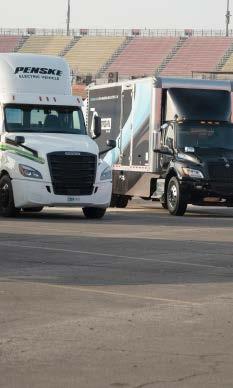CALSTART
Battery-electric trucks lower life cycle carbon emissions 44 to 79 percent

Lower total cost of ownership (TCO), including for heavy-duty tractors by 2030
$485 billion in health and environmental benefits if all MHD vehicles transition by 2040
Creates well-paying jobs in growing sectors of the economy
Higher utilization of the electrical grid will save ratepayers money
Action is needed to safeguard our supply chain from climate risks like stronger and more frequent disasters
The cost of inaction is far greater than the cost to transition to zero-emission trucks


ZETs have grown in popularity and availability in recent years
Over 5,480 ZETs on the road today
Over 140 zero-emission models available from more than 40 truck manufacturers
Capable of meeting the duty cycle requirements of the majority of freight routes
Ninety percent of the country’s largest fleets committed to fully transition to ZETs
More than 70 companies call for an acceleration in the growth of ZETs
Historic support available to help fleets transition, including financial incentives like vouchers, grants, and tax credits, utility programs and EV-friendly rates for charging, and technical assistance.
Utilities and public utilities commissions (PUCs) have robust planning processes that enable them to sufficiently match demand and supply of electricity. Significant new loads have been added to the grid in recent decades, whether in the residential (e.g., air conditioning) or industrial (e.g., data centers) sectors.
Furthermore, new demand from ZETs will increase gradually, as fleets scale deployments and coordinate with their utilities.
Electric utilities are well-positioned to meet the new demand from ZETs
Batteries are increasingly sustainable
ZET battery technology continues to improve, yielding more powerful, longer-lived batteries that require less precious metals.
1 2 3
There is also massive investment in domestic manufacturing, with U.S. battery manufacturing capacity expected to increase nearly twenty-fold between 2021 and 2030.
The industry is also pushing to extract high-value materials more sustainably and domestically.

Furthermore, recycling is expected to reduce virgin material demand by 28 percent by 2050
Charging infrastructure build-out is already underway
Depot Charging
Fleets must plan ahead in order to secure necessary site-level grid upgrades to support charging infrastructure. The majority of electric truck charging will take place at private depots, often overnight when electricity demand is low, so the need for new electricity generation will be tempered. The new generation that is needed is expected to be zeroemission as well, since clean energy is now cheaper than fossil fuel power plants.
Public Charging
In addition to depot charging, many companies – including major manufacturers and truck stop operators – have announced plans to build out public charging. Public charging is already available in California and Oregon, and historic federal funding is available to support states in building out ZET charging along key corridors. Charging-asa-service facilities and hydrogen refueling stations are also coming online, and temporary mobile charging solutions are increasingly available to help fleets in the interim.
The time for action is no w
In the past, the trucking industry has risen to the challenge of reducing NOx emissions to protect public health.
CALSTART is confident it will now do the same to reduce carbon emissions in line with U.S. commitments. As in the past, a clear nationwide market signal combined with financial support is critical. Historic investments through the Bipartisan Infrastructure Law and the Inflation Reduction Act are in place and ready to meet a strong EPA Greenhouse Gas Phase 3 rule.
Authors
Developed by Jessie Lund and Jacob Richard
If you have any questions or comments, you can contact the authors at jlund@calstart.org and jrichard@calstart.org.
CALSTART works with its member companies and agencies to build a high-tech cleantransportation industry that creates jobs, cuts air pollution and oil imports and curbs climate change. We work with the public and private sectors to knock down barriers to innovation, progress and drive the transportation industry to a clean and prosperous future.
Photo Credit: Run on Less – Electric by NACFE




